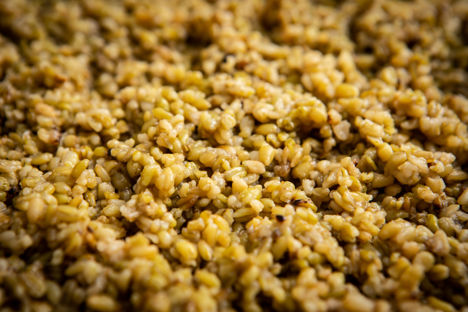
Freekeh: the smoky star of ancient grains
Though freekeh is packed with nutty earthiness, its distinctive smokiness is what sets it apart from other ancient grains and makes it a favourite among chefs. We take a look at freekeh’s fascinating story and how to use it.
Freekeh: the smoky star of ancient grains
Though freekeh is packed with nutty earthiness, its distinctive smokiness is what sets it apart from other ancient grains and makes it a favourite among chefs. We take a look at freekeh’s fascinating story and how to use it.
Like many of our favourite foods, freekeh is thought to have been discovered by accident. As an Eastern Mediterranean community prepared for attack, they picked the wheat they had been saving for the summer harvest early, while it was still young and green, to hide it away. Their efforts were wasted; the grain store was set ablaze anyway but, when it came to assessing the damage, instead of throwing the burnt wheat out, they rubbed the charred hulls and discovered that the grain left behind was not only edible, but smoky, robust and full of flavour. Though freekeh – which means 'rubbed' in Arabic – is commonly referred to as a grain, it’s actually named after that process; today, the grains are still pulled from the stem (usually of green durum wheat) while young and soft, a difficult process which means it is often picked by hand.
Boasting a lengthy history which is said to date back to 2300 BC in the Eastern Mediterranean and Middle Eastern regions (it’s even mentioned in the Bible, suggesting it was used in ancient Israelite times), it was long regarded as a staple, but it’s fair to say its popularity here has been somewhat more muted. Sometimes nicknamed the smoky cousin of bulgur wheat, it has traditionally been overshadowed by not only bulgur, but also quinoa and rye, which have developed reputations as superfoods in recent years. But the movement towards ancient and heritage grains (we forecast it as one of our nine food trends for 2024) is heralding a deeper exploration of a category which also includes kamut, sorghum and teff, fast adding new grains to our recipe roster.
Having been largely unchanged – and, importantly, unrefined – for thousands of years, ancient grains are typically less processed than modern grains, boasting more vitamin, mineral and fibre content (freekeh in particular is packed with calcium, potassium, iron and zinc, though it isn’t gluten-free, unlike other ancient grains), and also benefits when it comes to sustainability; they are generally hardier, less susceptible to drought and require less irrigation and pesticides.
Typically pale green or brown in colour, freekeh has a similar slightly chewy texture to bulgur wheat and the nutty earthiness typical of most grains, with the addition of its trademark smokiness. It’s usually cooked similarly to rice or quinoa, using a ratio of water to grain (often 2:1 or 3:1 – it can be bought in cracked or whole grain varieties, with the latter needing a longer cooking time) and then simmering, though it can also be cooked slowly, as you would with a risotto, in a pilaf. It’s still widely used in Middle Eastern cuisines; in Egypt you might find freekeh spiced with cinnamon, cumin and pepper and stuffed into pigeons or squabs, which are then grilled or roasted, for hamam mahshi, a dish often saved for special occasions. In Tunisia, it’s served in soup with bone marrow, while in Syria it’s more commonly found in a pilaf with chicken or lamb and in Algeria it’s an ingredient in traditional soup chorba frik, which is often made with lamb.
Freekeh's origins mean it lends itself well to dishes like tagine (Marcus Wareing uses it in a vegan aubergine and cashew tagine), as well as stews and traybakes. Its ability to soak up the flavours of whatever it’s cooked with mean it is delicious paired with meat and, in particular, lamb – Ramael Scully uses freekeh as a bed for his balsamic-glazed hogget shoulder, while we’ve paired it with apricot and pine nuts for a fantastic rotisserie chicken stuffing. Ultimately, its versatility is its strength; it can be weaved into summer salads (perhaps with pistachios and a citrusy vinaigrette) as well as hearty winter stews and soups packed with everything from lamb and kale to lentils (as Imad Alarnab does here). And while freekeh is more than enough to make a meal on its own, it’s also a great side dish – Peter Gordon’s freekeh, cumin-roast artichoke, grilled corn and pomegranate recipe could be the main event or a spectacular side. However you choose to use it, freekeh is an all-rounder brimming with flavour, texture and health benefits, and adaptable enough to use whatever the season.

